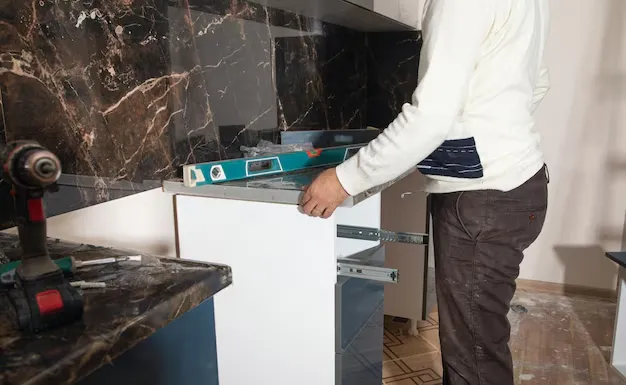
Blog
Dissecting the Core of Kitchen Design: A Deep Dive into Cabinet Craftsmanship

The kitchen is often heralded as the heart of a home, a space where functionality meets personal style. At the center of this dynamic environment lies an element that dictates both aesthetics and utility: the cabinetry. Far from being mere storage solutions, kitchen cabinets are structural and design cornerstones that can make or break the efficiency and appeal of your culinary space. In this expert analysis, we’ll peel back the layers of cabinet craftsmanship, exploring the nuances of materials, construction techniques, and design trends that define modern kitchen spaces. Whether you’re a homeowner planning a renovation or a designer seeking deeper insights, this exploration offers a meticulous breakdown of what truly matters.
The Anatomy of Quality: What Makes a Cabinet Stand the Test of Time?
When evaluating kitchen cabinetry, the first point of scrutiny is construction quality. A well-built cabinet isn’t just about appearances; it’s about enduring the daily rigors of a busy kitchen. Solid wood frames, for instance, offer unmatched durability compared to particleboard or MDF (medium-density fiberboard), which can warp under moisture or heavy use. Dovetail joints—a hallmark of traditional craftsmanship—provide superior strength over stapled or glued alternatives, ensuring drawers don’t falter after years of use.
Beyond the skeleton, the finish plays a critical role. High-quality paints or stains with protective coatings resist scratches, stains, and fading, preserving the cabinet’s look over time. Hardware, often overlooked, is equally vital. Soft-close hinges and full-extension drawer slides aren’t just conveniences; they reduce wear and tear, extending the lifespan of the unit. When sourcing options, it’s worth investing in trusted suppliers. For instance, when looking for Kitchen Cabinets, prioritizing vendors with a reputation for robust construction can save significant costs in repairs or replacements down the line.
Material Matters: Balancing Aesthetics with Practicality
The choice of material is a defining factor in both the visual impact and functionality of kitchen cabinetry. Hardwoods like oak, maple, and cherry remain perennial favorites for their natural beauty and resilience. Oak, with its pronounced grain, lends a rustic charm, while maple offers a smoother, more contemporary finish. Cherry, though softer, ages gracefully with a rich patina that deepens over time.
For those seeking modern alternatives, engineered materials like plywood with veneer overlays provide cost-effective durability without sacrificing style. Laminate and thermofoil finishes cater to minimalist designs, offering easy maintenance and resistance to humidity—a boon in steamy kitchen environments. However, beware of low-grade laminates that peel or bubble over time. Sustainability is another growing concern; reclaimed wood or bamboo cabinets appeal to eco-conscious homeowners, blending environmental responsibility with unique character.
The key is aligning material choice with your kitchen’s specific demands. A high-traffic household with young children might prioritize durability over intricate detailing, while a showpiece kitchen could justify splurging on premium hardwoods for maximum visual impact.
Design Dynamics: How Cabinet Layout Shapes Kitchen Flow
Beyond materials and build, the layout and design of cabinetry profoundly influence a kitchen’s functionality. The classic work triangle—connecting the sink, stove, and refrigerator—remains a guiding principle, and cabinet placement must complement this flow. Base cabinets should offer accessible storage for heavy pots and pans, ideally near the cooking zone, while wall cabinets can house lighter items like glassware or spices within arm’s reach of prep areas.
Modern design also embraces customization. Pull-out shelves, corner drawers with lazy Susans, and built-in organizers transform dead space into usable storage, addressing common pain points in kitchen organization. Open shelving, a trend gaining traction, breaks the monotony of closed cabinetry, allowing for decorative displays—but it demands discipline to avoid clutter. For smaller kitchens, vertical storage solutions or cabinets extending to the ceiling maximize space without compromising on style.
Color and finish further dictate the mood. Dark cabinets, such as deep espresso or charcoal, create a dramatic, sophisticated ambiance but can shrink a compact space. Conversely, lighter tones like cream or pale gray reflect light, enhancing openness—an ideal choice for tighter layouts. The interplay of cabinet design with countertops, backsplashes, and flooring is the final piece of the puzzle, requiring a keen eye for cohesion.
Future-Proofing Your Investment: Trends vs. Timelessness
Kitchen design trends evolve rapidly, and cabinets are often the focal point of these shifts. Currently, two-tone cabinetry—pairing contrasting colors or finishes between upper and lower units—adds visual interest without overwhelming. Matte finishes are overtaking glossy surfaces, offering a subtle elegance that hides fingerprints better than their shinier counterparts. Integrated handles or push-to-open mechanisms are also on the rise, delivering a sleek, handle-less look that aligns with minimalist sensibilities.
Yet, chasing trends can be a double-edged sword. A hyper-modern design might feel dated in a decade, reducing resale value or necessitating costly updates. The savvier approach is balancing trendy elements with timeless foundations. Opt for neutral base tones in durable materials, then layer in fashionable accents through hardware or backsplash tiles that are easier to swap out. This hybrid strategy ensures your kitchen remains relevant without locking you into a fleeting aesthetic.
Conclusion: Crafting a Kitchen That Endures and Inspires
Kitchen cabinetry is far more than a utilitarian feature; it’s a canvas for personal expression and a backbone of practical design. From the intricacies of construction to the strategic selection of materials and layouts, every decision shapes how your kitchen performs and feels. As we’ve dissected in this analysis, quality craftsmanship, thoughtful material choices, and intentional design are non-negotiable for creating a space that stands the test of time—both structurally and stylistically.
Whether you’re embarking on a full renovation or a subtle refresh, remember that cabinets are an investment in your home’s functionality and value. Take the time to weigh durability against design, trends against timelessness, and always prioritize sources that deliver on both quality and expertise. A kitchen built with such care doesn’t just serve meals; it becomes a lasting centerpiece of daily life, blending form and function in perfect harmony.

